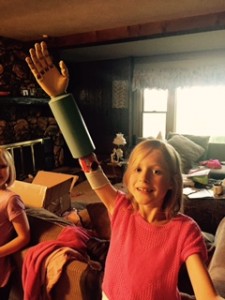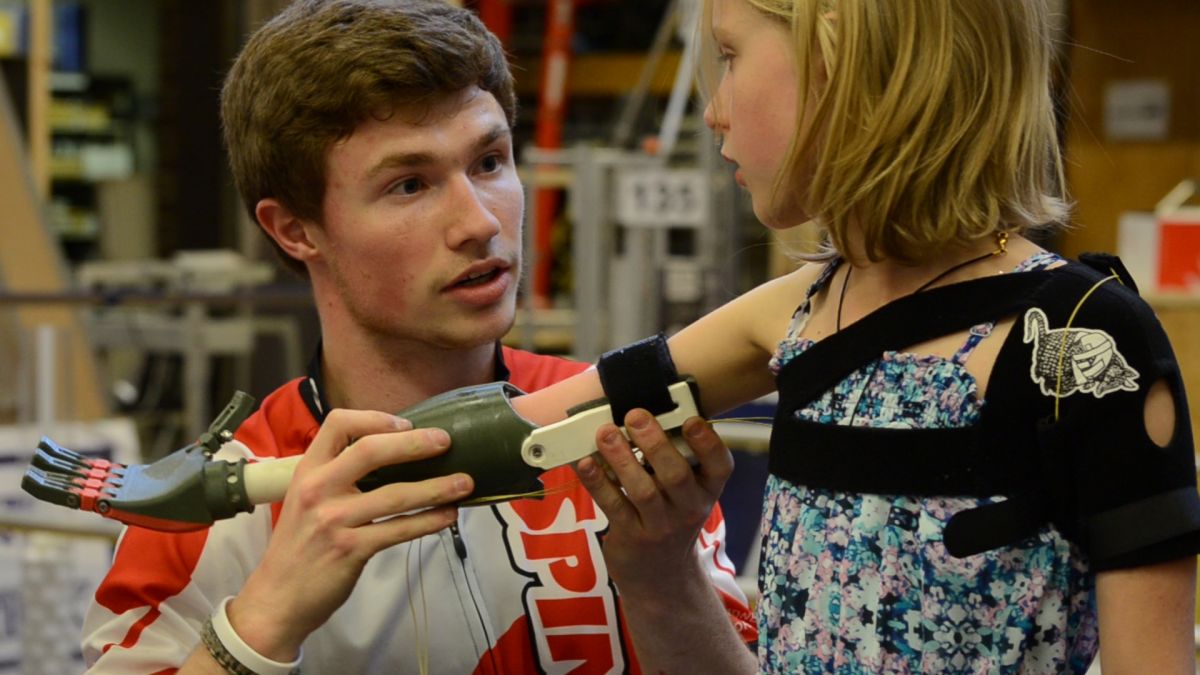She calls it her little arm. Grace, a 3rd grader in the Penn-Harris-Madison school corporation, was born with only part of her right arm. In December of 2014, Madison Elementary School principal, Aaron Leniski, reached out to Penn’s Engineering instructors with an idea. A big idea.
The Penn High School Engineering students would develop a community outreach project to help Grace acquire the function of both of her arms. They would build Grace a robotic arm.
Mr. Leniski, a former Penn Engineering student himself, saw this opportunity for Penn’s Engineering classes to aid a Madison Elementary 3rd grader. Mr. Leniski contacted the Penn Engineering faculty, who have the ability to print in 3D. Leniski’s idea was simple: they could print Grace a prosthetic arm.
Planning took off, and the Penn Engineering classes took the first steps on what turned out to be a five month journey. The classes began the project by researching 3D printed prosthetics. Grace’s mom had done some researching of her own and had found a group called eNable that designed 3D printed prosthetic arms.
“While we were researching different hand designs that were already out there, we found two that we liked from the eNable website. eNable uses Thingiverse to get their designs,” Penn Engineering Instructor, Josiah Parker said. Thingiverse.com is a design center where people in the design community can publish their 3D-printable things. These published designs serve as open sources for anyone to use, remix, or redesign. From this website, the students gathered ideas, files, suggestions, and information.
Penn is so involved in this community project thanks to their access to a 3D printer. The printer;s home is room 142; the robotics lab. With the printer, the engineering students can make solid, plastic, 3-dimensional parts and pieces for their projects. Prior to the printing of the hand, things ranging from trinkets to tools have all been manufactured with their printer. What begins as a digital file is transformed into a solid object.
In January of 2015, Mr. Parker and Mr. Langfeldt took a handful of students with them to Grace’s home to gather information about Grace and her little arm. They asked her questions that allowed them to gain insight about what she wanted out of the arm they were creating. During the visit, they learned that her favorite color is green, the hand needed to be comfortable, functional, and fun, and she wanted to be able to paint her fingernails. Grace specifically asked for the hand and arm to stand out, like a robot.
The students took this information back with them to Penn, where planning and designing set sail. Each of the four engineering classes involved were making a different arm. One was to be printed off of the internet, two were found online and modified by students, and one design was made completely from scratch. Two of the arms are mechanical and two are electronic. The two electronic arms will run on battery powered mini-computers that can be plugged in to charge at night. The other two are operated with mechanics. In other words: no electronics.
This project was kept relatively secret; not many students outside of the groups involved in the making of the hand knew about the project’s existence. It was kept a secret so that an event could be made out of the unveiling of the finished arms to the public.
Grace came in to Penn 6 days before the public reveal. While here, she tried on the baby blue dress that a handful of sewing students made. Grace would jump into the air, letting the ocean of blue material billow around her. When her feet landed, she would sink to the ground, bunching the aqua sparkles up in a cylinder around her body. She looked like a little blue marshmallow; a marshmallow covered in glitter, that is. She also tried on the two arms that were finished.
When they unveiled the first arm, she seemed very quiet. She was obviously less than impressed with the army-green colored arm. It seemed heavy and bulky, and not at all like a nine-year-old little girl. They helped her into a shoulder strap, since she couldn’t quite bear the weight and length of the arm on her own. The arm was supposed to work with electronics. Sensors that were to attach to her arm would recognize that she was flexing it. When this recognition occurred, the hand was to close. Unfortunately, when testing the sensors on Grace’s little arm, the sensors would not work.
The second arm they presented to Grace was much more Gracie-sized. It had a white, rotatable wrist and the same army-green forearm and hand as the other arm. The space that she was supposed to nestle her little arm into was not quite long enough: her little arm would slip out of it when she lifted it up. Again, she seemed less than impressed.
Since then, the first arm they presented to Grace was painted baby blue, like she asked for. The new color seems to give the situation new life. The sensors that Penn had gotten a hold of had proven mostly unreliable. Instead, the students re-wired the arm so that it would work with the push of a button, found on the side of the, now blue, arm. On top of that, the students printed a different forearm, one that was much shorter and much more fitting for an elementary aged girl.
“The triumphs were small many times but well worth it. The disappointments were often huge but the students plowed through,” said Parker. “The designs that are not done will hopefully be completed in the next couple of weeks for Grace. Some of them may be left for next year.”
The public reveal will be held on Wednesday, May 27th in Penn High School’s Center for Performing Arts. Grace will be treated like a movie star, complete with a documentary created by a Penn media arts student. She will arrive to her movie premiere in a limo with her family after a dinner at Papa Vino’s. The documentary will be aired at around 7:00 pm, the same time that Gracie is supposed to set foot to the red carpet. The public is welcome to attend and witness this uplifting event. Enter through door C at 6:30 pm.
“It was a wonderful learning experience for all of us and it is something the students will never forget,” concludes Parker.


